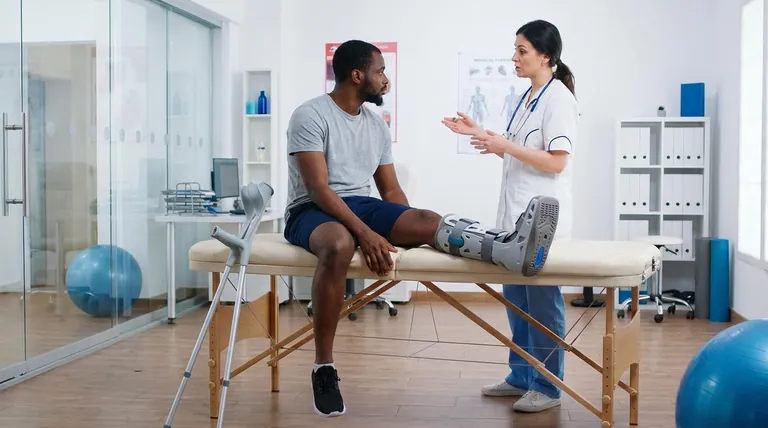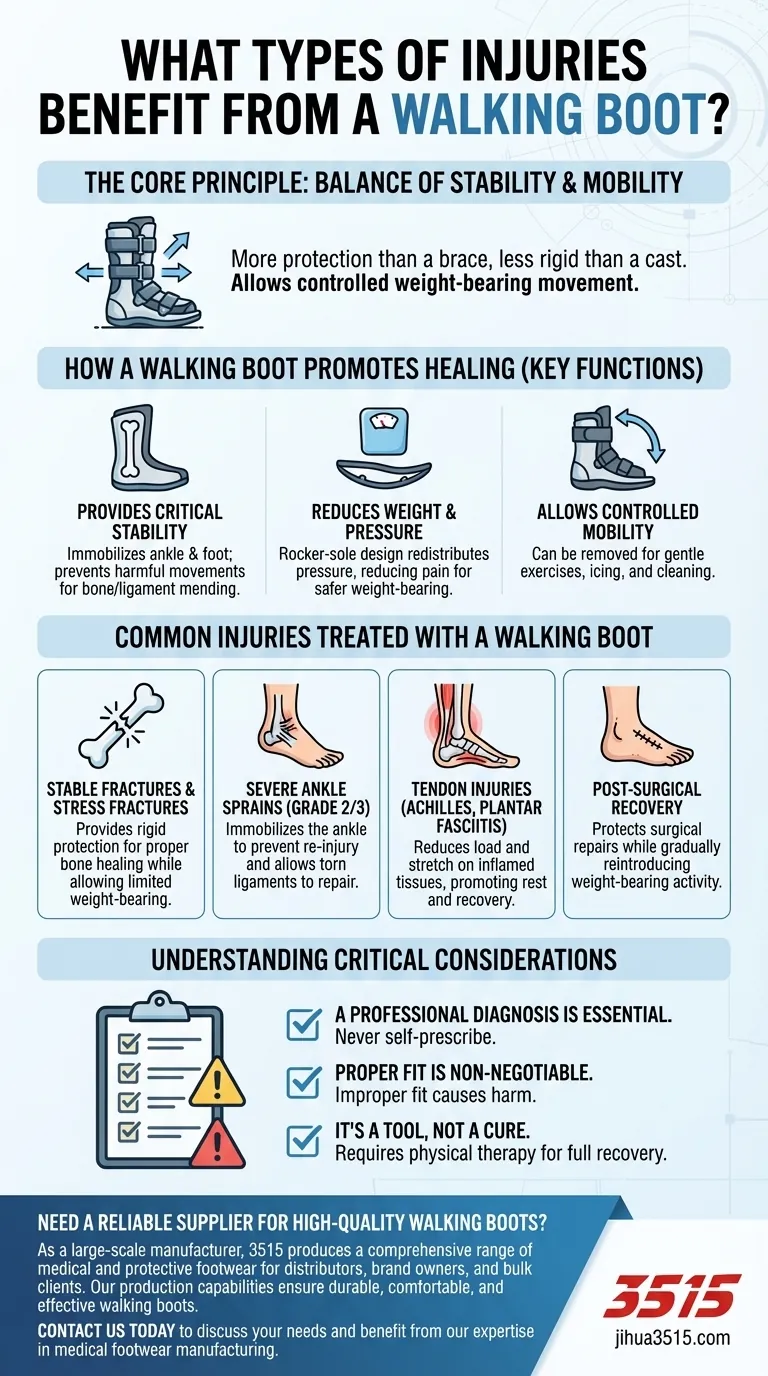A walking boot is most often prescribed for injuries that require significant stabilization but can still benefit from limited, weight-bearing movement. These commonly include moderate-to-severe ankle sprains, stress fractures, stable fractures of the foot or ankle, and significant tendon or soft tissue injuries.
The core principle is not the specific injury, but the required healing environment. A walking boot is used when an injury needs more protection than a simple brace but less rigid immobilization than a traditional cast, allowing for a balance of stability and controlled mobility.

How a Walking Boot Promotes Healing
A walking boot, or controlled ankle motion (CAM) boot, is a medical device engineered to accelerate recovery by managing the forces placed on your lower leg. It accomplishes this through several key functions.
Providing Critical Stability
A boot features a rigid outer shell that immobilizes the ankle and foot, preventing harmful movements that could delay healing or worsen the initial injury. This support is crucial for allowing broken bones and torn ligaments to mend without disturbance.
Reducing Weight and Pressure
The rocker-sole design of a walking boot helps redistribute pressure away from the injured area as you walk. This offloading effect reduces pain and allows you to bear weight on the leg sooner and more safely than you otherwise could.
Allowing Controlled Mobility
Unlike a hard cast, a walking boot can be removed. This allows for gentle, controlled range-of-motion exercises as advised by a professional. It also permits icing and cleaning of the area, which is vital for managing swelling and maintaining hygiene.
Common Injuries Treated with a Walking Boot
While a medical professional must make the final determination, walking boots are typically used for a specific range of lower leg, ankle, and foot injuries.
Fractures and Stress Fractures
For stable fractures (where the bone is not displaced) of the foot or ankle, a walking boot provides the necessary protection for the bone to heal correctly. It is also a primary treatment for stress fractures, which are tiny cracks in a bone caused by overuse.
Severe Sprains and Strains
A Grade 2 or Grade 3 ankle sprain, where ligaments are significantly stretched or torn, often requires the stability of a boot. The immobilization prevents the ankle from rolling and allows the damaged ligaments to repair.
Tendon and Soft Tissue Injuries
Conditions like a torn Achilles tendon, severe tendonitis, or plantar fasciitis can benefit from a boot. It works by reducing the load and stretch on the inflamed or injured tissues, giving them a chance to rest and recover.
Post-Surgical Recovery
Following surgery on the foot or ankle, a walking boot is often used to protect the surgical repair. It provides a stable environment for the tissues to heal while gradually reintroducing weight-bearing activity into the recovery process.
Understanding the Critical Considerations
Using a walking boot is not always a straightforward solution. For it to be effective and safe, you must avoid common pitfalls and recognize its limitations.
A Professional Diagnosis is Essential
You should never self-prescribe a walking boot. A medical professional, such as a podiatrist or orthopedic specialist, must assess the injury's severity, location, and stability to determine if a boot is the appropriate treatment.
Proper Fit is Non-Negotiable
An improperly fitted boot can cause more harm than good. It can create pressure sores, alter your gait in a way that causes secondary pain in your knee or hip, or fail to provide adequate support for the injury.
It's a Tool, Not a Cure
A walking boot is just one component of a comprehensive recovery plan. Healing almost always requires physical therapy and rehabilitation exercises to restore strength, flexibility, and balance to the injured area once the boot is no longer needed.
Making the Right Choice for Your Recovery
Your approach should be dictated by the nature of your injury and the guidance of your healthcare provider.
- If you suspect a fracture or have experienced a severe sprain: Seek immediate medical evaluation to get an accurate diagnosis and a formal prescription for the correct supportive device.
- If you are recovering from surgery: Adhere strictly to your surgeon's instructions regarding when and how to wear the boot and how much weight you can put on it.
- If you have a chronic issue like plantar fasciitis or shin splints: Consult a specialist to determine if a boot is a useful part of a broader treatment plan that may include orthotics, stretching, and physical therapy.
Properly used under medical guidance, a walking boot is a powerful tool for ensuring a safe and structured recovery.
Summary Table:
| Injury Type | How a Walking Boot Helps |
|---|---|
| Stable Fractures & Stress Fractures | Provides rigid protection for proper bone healing while allowing limited weight-bearing. |
| Severe Ankle Sprains (Grade 2/3) | Immobilizes the ankle to prevent re-injury and allows torn ligaments to repair. |
| Tendon Injuries (Achilles, Plantar Fasciitis) | Reduces load and stretch on inflamed tissues, promoting rest and recovery. |
| Post-Surgical Recovery | Protects surgical repairs while gradually reintroducing weight-bearing activity. |
Need a reliable supplier for high-quality walking boots? As a large-scale manufacturer, 3515 produces a comprehensive range of medical and protective footwear for distributors, brand owners, and bulk clients. Our production capabilities ensure durable, comfortable, and effective walking boots to support your customers' recovery journeys. Contact us today to discuss your needs and benefit from our expertise in medical footwear manufacturing.
Visual Guide

Related Products
- Customizable Anti-Smash Safety Boots for Wholesale & Private Label Manufacturing
- Premium Wholesale Waterproof Safety Boots High Performance Protection for Industrial Markets
- Custom Wholesale Leather Safety Boots Direct Factory Manufacturing
- Premium Grain Leather Safety Boots for Bulk Supply
- Durable Rubber-Soled Utility Shoes for Wholesale & Custom Brand Manufacturing
People Also Ask
- Why is the last important in work boot design? It's the Anatomical Blueprint for Comfort & Safety
- Is safety toe better than steel toe? A Guide to Choosing the Right Protection
- Is there a downside to steel toe boots? Weighing Protection Against Daily Comfort
- What are the differences between steel toe, composite toe, and alloy toe Wellington boots? Choose the Right Safety Toe for Your Job
- Is safety-toe as good as steel toe? Choose the Right Protection for Your Job



















